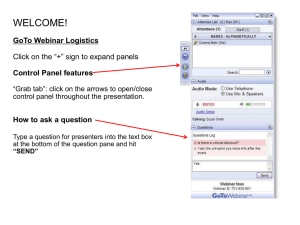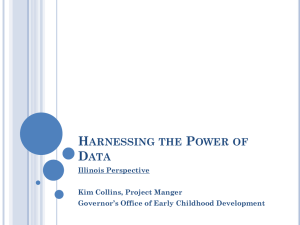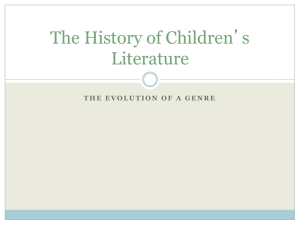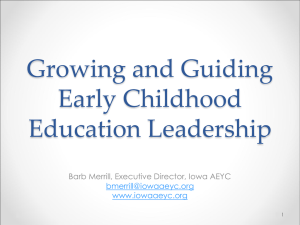Coordinated Longitudinal Early Childhood Data Systems
advertisement
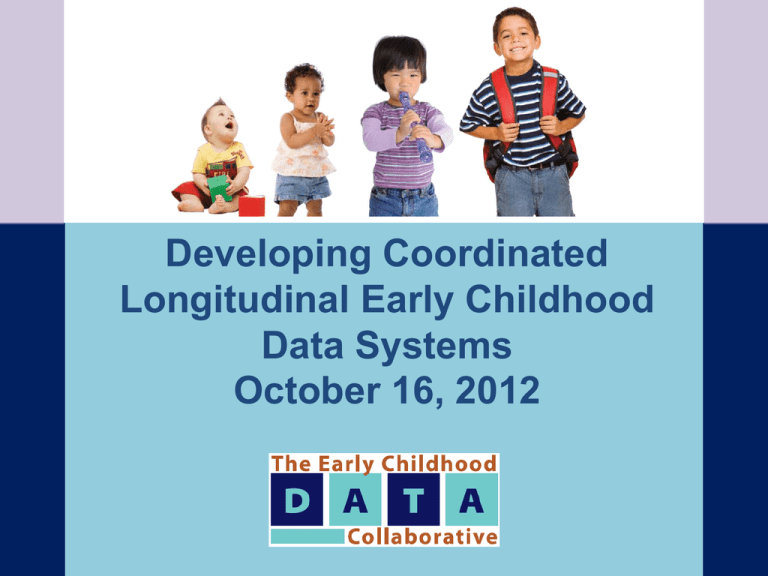
Developing Coordinated Longitudinal Early Childhood Data Systems October 16, 2012 Twitter Town Hall Co-Hosts Child Trends, @childtrends Data Quality Campaign, @EdDataCampaign New America Foundation, @lisaguernsey Center for Law and Social Policy, @hnmatthews Use the hashtag #ecdata to tweet questions and comments Agenda Welcome and ECDC Overview Elizabeth Groginsky, Executive Director of the ECDC Report Overview and Findings Amanda Szekely, National Governor’s Association Center for Best Practice, Co-author of the report State Highlights Illinois - Jon Furr, University of Illinois Massachusetts - Sherri Killins, Department of Early Education and Care North Carolina - Anne Bryan and Kristen Guillory, Early Childhood Advisory Council Question and Answer Poll Question Please select the role that best describes you Researcher State Administrator Policy maker Practitioner Business leader Other The Early Childhood Data Collaborative (ECDC) Mission Promote policies and practices that support states’ development and use of early childhood data systems. Guiding Principles From compliance-driven to improvement-driven data systems From fragmented data systems to coordinated data systems From “snapshot” data to longitudinal data systems ECDC Partners Child Trends is the Hub Center for the Study of Child Care Employment at UC Berkeley Council of Chief State School Officers Data Quality Campaign National Conference of State Legislatures National Governors Association Center for Best Practices Pre-K Now, a campaign of the Pew Center on the States Supported by funding from the Birth to Five Policy Alliance 6 6 10 Fundamentals 1. 2. 3. 4. Unique statewide child identifier Child-level demographics and program participation information Child level data on development Ability to link child level data with K-12 and other key data systems 5. Unique program site identifier with the ability to link with children and the ECE workforce 6. Program site structural and quality information 7. Unique ECE workforce identifier with ability to link with program sites and children 8. Individual-level data on ECE workforce demographics, education and professional development information 9. State governance body to manage data collection and use 10. Transparent privacy protection and security policies and practices 7 7 Report Overview Developing Coordinated and Longitudinal Data Systems: Trends and Opportunities in the Race to the Top Early Learning Challenge Applications (RTT-ELC) 30 of 37 applicants addressed optional priority to build or enhance an early learning data system Nine states (six of which addressed data systems priority) won grants in 2011 Five more states will receive grants in 2012, four of which addressed data systems priority 8 8 Trends in RTT-ELC Applications Making data accessible to improve and inform ECE practice and policy; Linking existing ECE data systems; Filling ECE data gaps, including workforce and child development data; Strengthening the connection between ECE data and data from other systems; and Developing interagency data governance structures. 9 9 Making Data Accessible States set goals to provide data to policymakers, ECE providers, parents, etc. Proposed strategies include: web portals, dashboards, scorecards, and reports tailored for different users. Pennsylvania proposed a “provider scorecard” to compile data on individual ECE program sites, including QRIS information, workforce qualifications, child outcome information, etc. Minnesota proposed new early learning data portal with dashboards and reports that meet the needs of educators, administrators, and parents. States proposed to build users’ capacity to understand and use data. 10 10 Linking Existing Data Systems States proposing various approaches, including “data warehouses” vs. “federated” systems; Proposed strategies to facilitate linkages: Identifiers to match records among datasets that represent the same child, program site, or provider/teacher; Common data standards to ensure that data fields represent the same type of information when linking databases; and Data-sharing agreements to develop formal documents that define how data would be linked and used. 11 11 Filling ECE Data Gaps States proposing to fill two significant gaps identified through ECDC 2011 state survey: Expanding data on the ECE workforce by strengthening and expanding the reach of workforce registries. Collecting data on child development by capturing data on developmental screenings, formative assessments, and kindergarten entry assessments (KEA). 12 12 Strengthening the Connection between ECE data States propose to strengthen data linkages with: K-12 state longitudinal data systems Head Start Health and human services data 13 13 Developing Interagency Governance Structures Governance structures would set state policies to guide data collection, access, and use. Strategies include: Developing new interagency data governance bodies; Leveraging existing SLDS governance structure; Establishing data governance body within Early Childhood Advisory Council. 14 14 Illinois: Strategies to link ECE data Jon Furr, Director of the Office of Education System Innovation at Northern Illinois University 15 15 Overview 16 16 Illinois SLDS Background RTT-ELC Analytical Framework Building bridges across EC systems Future challenges Illinois SLDS: Beginning Stages ISBE’s 2001 IT Strategic Plan: Statewide Student Information System (SIS) e-Grants management system Data warehouse SIS: Statewide deployment in 05-06 17 17 Unique Student ID (not SSN) Student enrollment data and program information Student demographic information State assessment data Extended to State-funded PreK programs P-20 Longitudinal Ed. Data System Act P.A. 96-0107, signed into law in July 2009 Established the requirements and framework for the development of the state’s longitudinal education data system by: Setting forth a long-term vision for the state’s education data system, Requiring the state to implement all of the DQC 10 essential elements, Requiring the longitudinal data system to support a broad array of state and LEA educational functions, Establishing a framework for data sharing with outside entities to support research and evaluation consistent with privacy protection laws. Early learning data a priority; ISBE authorized to collect necessary early learning data 18 18 IES Grant #1: $9M; April 09 1. Development of an Enterprise-wide Data Architecture 2. Improved Data Quality through Data Stewardship 3. Development of an Education Enterprise Data Warehouse 19 19 IES Grant #2: $11M; Spring 10 Expansion of Early Childhood Data Collection Systems ISBE commences collecting data from infant and toddler programs that are funded through the Early Childhood Block Grant (ECBG) into the state longitudinal data system ISBE captures information on all of the ECBG-funded programs in Illinois serving children from birth to five 20 20 RTT-ELC Analytical Framework RTT-ELC Essential Data Elements Categories Children & Families Workforce Program Unique statewide child identifier Unique EC Educator identifier Unique program site identifier Child and family demographic information EC Educator Demographic Information Program-level data Child-level program participation and attendance data A tale of two cities… Illinois State Board of Education Illinois Department of Human Services A tale of two cities… Illinois State Board of Education Illinois Department of Human Services Workforce Establish Gateways to Opportunity Registry as a comprehensive repository Rule changes to include more educators Web service integration with ISBE certification data Program Establish the Data Tracking Program as the comprehensive provider database for QRIS monitoring and supports Integration with DCFS licensure data Integration with ISBE preschool data 25 25 Children and Families Education and Workforce Data 26 26 ISBE IDHS Health and Human Services Data Workforce Data Quality Initiative 27 27 IDHS: Integrated Eligibility System Childcare IES Early Intervention 28 28 Case Management Matching across WDQI and IES Matching procedures Web service extractions Childcare IES Early Intervention 29 29 Case management LDS Governance P-20 LDS Act contemplates a federated governance structure Linkages by Intergovernmental and Data Sharing Agreements Need a governance structure that cuts across workforce, education, and early childhood data 30 30 Making Data Accessible My State built an LDS and all my teachers got was this stupid T-shirt 31 31 Teacher Portal/ Instructional Improvement System Student Data Learning Maps Curriculum/ Assessment Tools Lesson Plans Professional Development Illinois Shared Learning Environment (powered by the Shared Learning Collaborative: www.slcedu.org) 3 Thank you! Jonathan Furr Director Office of Education System Innovation Northern Illinois University jfurr@niu.edu 33 33 Massachusetts: Data accessibility Sherri Killins, Commissioner of Massachusetts Department of Early Education and Care 34 34 Background In 2005, the Commonwealth of Massachusetts became the first state in the nation to create one agency to oversee early education and care and outof-school time programs for families. The Department of Early Education and Care (EEC) was created by consolidating the former Office of Child Care Services with the Department of Education’s (now the Department of Elementary and Secondary Education) Early Learning Services unit. 35 35 Purpose of EEC’s Establishment EEC was established within the context of strong evidence from brain development research showing the long-term impact of high-quality early education and its potential return on investment. The goal of the consolidation was to create a single, unified, more efficient system of early education and care in Massachusetts that is better responsive to the educational and developmental needs of children and to the vital role of families in a child’s health, development and success. 36 36 Governance – EEC Board Board of Early Education and Care • 11 Members • Meets 10 times/year (2nd Tuesday) Board Members o o Sec. of EOHSS JudyAnn Bigby, M.D. o Joan Wasser Gish o Sharon Scott Chandler o Elizabeth Childs, M.D. JD Chesloff, Chair o Sec. of Education Paul Reville o o o o Commissioner/ Board Secretary •Sherri Killins Eleonora Villegas-Reimers Chi-Cheng Huang, M.D. Cheryl Stanley Mary Walachy Carol Craig O’Brien Advisory Groups • EEC Advisory Team • Parent Advisory Team MA Education Governance Structure Executive Office of Education Secretary of Education Paul Reville Department of Early Education and Care Department of Elementary and Secondary Education Sherri Killins Mitchell Chester Department of Higher Education Richard Freeland The Call for Collective Action “As we contemplate the future of our Commonwealth, and the future of our country and world, we must think differently and act more creatively about how we create consistent excellence throughout public education. We must break down the silos that characterize our approach to public education. Instead, we must create a continuum of teaching and learning dedicated at every turn to the academic and personal success of each individual student… (The Patrick Administration Education Action Agenda) provides an action agenda for establishing universal excellence over the next decade. Recognizing that no one idea will transform the system, the agenda leverages the relationships within the education sector and among all sectors of society. As we implement these action items, my administration will continue its commitment to the collaboration and cooperation that are the hallmarks of the Commonwealth Readiness Project. Taken together, and with all stakeholders working together, I am confident that we can deliver on a new 21st century promise of high-quality public education for all Massachusetts residents.” --READY FOR 21ST CENTURY SUCCESS: THE NEW PROMISE OF PUBLIC EDUCATION; The Patrick Administration Education Action Agenda, June 2008 39 39 EEC Duties: Child/Educator Databases Massachusetts General Law (MGL) Ch.15D: (q) establish and regularly update: (1) a comprehensive database of early childhood educators and providers, hereinafter referred to as the educator database, for the purpose of enhancing the workforce development system; and (2) a comprehensive database of children both waiting for and receiving early education and care services, in this chapter called the student database, that is compatible with relevant databases at the department of elementary and secondary education and the executive office of health and human services; and 40 40 Core Areas of Focus EEC is focused on strengthening the system of early education and care in Massachusetts as a critical element of the education pipeline from cradle to career. The child outcomes that we are trying to achieve require investment in four critical areas: teacher quality, program quality, screening and assessment, and engagement of communities and families. The system EEC is building includes all children, not just those who are subsidized or in formal care. 41 41 Early Childhood Information System (ECIS) Massachusetts has set out four broad uses for the ECIS data system: Providing parents/families with information about early learning and development programs available to them and giving them the information needed to support their children development; Providing programs and services with information about the children they are serving and to improve individualized teaching and learning at the classroom and program level through formative assessment; Providing policy makers with information about the current use of early learning and development programs, capable of disaggregation to a local level and by different groupings of children (with a particular emphasis upon children with high needs), in order to: 42 42 identify service gaps and needs, track trends in addressing those gaps and needs over time, and identify the combinations of best practices in engaging children in services which show positive early childhood outcomes, that can be used to inform further investment and systems improvement; Provide an opportunity for state agencies to understand where children may be served by multiple systems that would benefit from greater coordination and integration. ECIS: Scope 43 43 The ECIS is an early learning data system that has been collaboratively designed to provide information that will improve instruction, practices, and services for early education programs, educators, and families. What information is collected in ECIS? Child and family demographic information Early Childhood Educator demographic information, including data on educational attainment and State credential or licenses held, as well as professional development information Program-level data on the program’s structure, quality, child suspension and length of time in programs, rates, staff retention, staff compensation, work environment, and all applicable data reported as part of the State’s Tiered Quality Rating and Improvement System Child-level program participation and attendance data Early Childhood Information System (ECIS) 44 44 ECIS will be used to improve the state’s ability to target opportunities to support a child’s growth from birth to 5, as well improve program and educator quality. The Commonwealth’s Bold Vision: Core Elements of the Early Childhood Information System Family Engagement Parental Consent Core Child Level Data Self- Assessment Data Child Development Screening and Assessment Data Collected through ASQ, EVT, PVT, Social and Emotional Test, WoodcockJohnson Interagency Data Sharing Interagency Service Agreements (ISAs) Key risk and protective factors Strength and Risk Analyses Pull and match child-level data from above data sources Report out on child-level critical strength and risk factors Communication General communication to all families on general child development advice and guidance and information on community events and resources Families with high needs children receive targeted communications on state agency resources and community supports 45 45 Data from parents, screenings, assessment, and demographic data will feed ECIS to generate valuable reports and information 3 2 Parent/Child Registration Portal CCFA ASQ 1 Multi-dimensional Data CCIMS eCCIMS LM QRIS ECIS Data Warehouse Departmental Datamarts Business Intelligence Community and family outreach 46 46 5 Dashboards PQR KEY 1 EEC data warehouse 2 Data loading process 3 Child data feeds 4 Reporting capabilities 5 Establish outreach 4 Self-Service Data and Reports Conceptual Structure of ECIS Advancing the ECIS in Massachusetts EEC Data Warehouse Architected and Loaded COMPLETED Staffing COMPLETED Platform/Tool Selection and Training COMPLETED Legacy Systems Integration COMPLETED Initial Build of the EEC Data Warehouse COMPLETED Cleansing/de-duplication IN PROGRESS Loading of the EEC Data Warehouse IN PROGRESS Initial Loading of the Data Marts IN PROGRESS Validation/Testing IN PROGRESS Requirements: Federal RTTT Reporting: IN PROGRESS Reporting: Development NOT STARTED Reporting: Agency and inter-agency reporting NOT STARTED ONGOING Participation in LDS/P20 project Data collection consent discussions 47 47 FY13 Budget Support for Data Sharing 48 48 A data sharing pilot program between the department of early education and care, the department of elementary and secondary education, the executive office of education, the department of public health and the executive office of health and human services to assign a state assigned student identifier to children participating in early intervention programs with the goal of tracking and evaluating educational and developmental outcomes for children receiving early intervention services, improving delivery of services and determining cost savings associated with the early intervention program; provided, that any pilot program shall be contingent upon informed consent from participating families… The agencies must report by March 15, 2013 on: (i) the progress made on implementation of the pilot program, including but not limited to, the criteria used for selecting sites and preliminary implementation plans for the assignment of state assigned student identifiers to children receiving early intervention services; (ii) a timetable for full implementation of the pilot program including resources needed to meet the proposed timetable; (iii) a plan for obtaining informed consent from families receiving early intervention services; (iv) the number of state assigned student identifiers that have been assigned to date, if applicable; and (v) recommendations on how the department of public health and the agencies of the executive office of education can rigorously evaluate the effect of early intervention services on the future special education needs of program participants; North Carolina: Governance structures Anne Bryan, Executive Director of the North Carolina Early Childhood Advisory Council Kristen Guillory, North Carolina Early Learning Challenge grant manager 49 49 NC Early Childhood Advisory Council Established by Governor in 2010 Broad representation of state and local agencies and perspectives in serving young children and families Purpose: To create and sustain a shared vision for young children and a comprehensive, integrated system of high-quality health, family strengthening, and early care and education services to achieve the best possible outcomes for the state’s young children Lead agency for the Race to the Top - Early Learning Challenge in North Carolina Early Learning Challenge in NC Goal: Each and every child comes to kindergarten ready for success in school and in life Four major focus areas: Strengthen the early childhood system Enhance program quality and access Strengthen the early childhood workforce Target high-intensity support in a high-need Transformation Zone $ 8.9 M of the $70 M grant allocated to the development of the Early Childhood Integrated Data System (ECIDS) Vision for the Data System (ECIDS) A major system-building initiative to provide the information needed to enhance services for young children and improve outcomes Approach: Create a data system that integrates data from different agencies that serve young children to provide timely and accurate information for system-wide planning and efficient and effective implementation of services Promote shared accountability for outcomes among early childhood programs and services Elements of the ECIDS Design Oversight by the Early Childhood Advisory Council System development by the State Information Technology Services agency Interagency coordination and decision making for the ECIDS development and data management through the implementation of a Data Management Group Collaboration with major partner agencies, including: State agencies participating in Early Learning Challenge NC Partnership for Children (Smart Start) Staffing ECIDS Specialist on the Early Learning Challenge grant management staff Information Technology Services Staff – Project Director, Project Manager, Business Analyst, Technical Architect Collaboration with and funding for staff in each participating state agency for program requirements and technical development: Department of Public Instruction Division of Child Development and Early Education Division of Public Health Data Management Group Early Childhood Data Management Group to be created using the existing Data Management Group (DMG) of the NC Department of Public Instruction as the model www.ncpublicschools.org/data/management/ Voting representation from each participating agency to ensure interagency coordination and decision making Data Management Group … continued Discuss and resolve issues regarding development of the ECIDS application and associated data collection, management, and use Address long-term evolutionary needs of the ECIDS application Keep the Early Childhood Advisory Council apprised and elevate policy issues, as needed Represent early childhood on the NC P-20W Council: www.ncpublicschools.org/data/ncp-20w/ Looking forward in North Carolina Learning process with many lessons ahead over the next three years Our interagency governance strategy is critical to the ECIDS development process Contacts: Anne Bryan, Executive Director, North Carolina Early Childhood Advisory Council anne.bryan@nc.gov Kristen Guillory, Project Manager, North Carolina Early Learning Challenge Grant kristen.guillory@nc.gov Question and Answer 58 58 Resources Child Trends Data Bank http://www.childtrendsdatabank.org The one-stop source for the latest national trends and research on over 100 key indicators of child and youth well-being. CLASP Datafinder: http://www.clasp.org/data/ CLASP Child Care and Early Education Data Tool: Using Data to Inform a State Early Childhood Agenda http://www.clasp.org/babiesinchildcare/publications?id=0010 Data Quality Campaign http://www.dataqualitycampaign.org PreK-12 Interactive Database of the Federal Education Budget with state and school-district data: http://febp.newamerica.net/; 59 59 Contact the ECDC Elizabeth Groginsky Executive Director Early Childhood Data Collaborative egroginsky@ecedata.org 202.572.6117 Join the ECDC Listserv at www.ecedata.org 60 60
